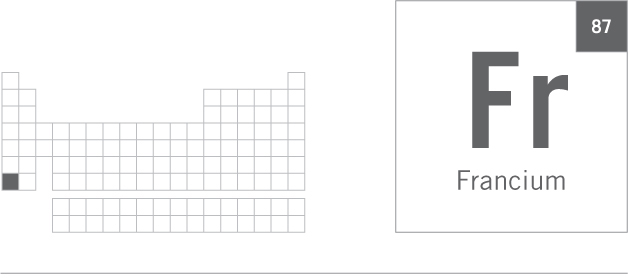Fr props up the alkalis, so fleetingly it glows,
Yet Perey’s bench-work prowess help’d its presence to expose.

Fr props up the alkalis, so fleetingly it glows,
Yet Perey’s bench-work prowess help’d its presence to expose.
eff-arr
THE LAST OF THE GROUP 1 ALKALI METALS
[prop up: phrasal verb — to support or bolster from underneath]
Francium is the last and the heaviest of the alkali metals and sits at the bottom of group 1 on the periodic table. It’s a highly radioactive element that occurs naturally in uranium ores via the following process. Uranium-235 decays (via thorium-231 and protactinium-231) to produce actinium-227. In turn, actinium-227 decays via alpha particle emission to yield the extremely rare and short-lived francium-223.
Little is known about francium’s properties and chemical reactivity due to its fleeting existence. Earth’s crust contains no more than an estimated 30 g of the element at any given time. But researchers at the State University of New York at Stony Brook managed in 1997 to assemble some 10,000 francium atoms in one location. Their painstaking efforts were rewarded with the sight of a fluorescent glow from the collection of atoms as it quickly decayed away!
Francium was the last element to be discovered in nature. French physicist Marguerite Perey (1909–1975), drawing on her considerable laboratory skills (likely honed while previously working as Marie Curie’s laboratory assistant), isolated the element in Paris in 1939. Perey found while studying the radioactive emissions from a meticulously purified sample of actinium that she could only account for the decay pattern of 99 percent of the actinium. Her eureka moment came when she realized that the remaining 1 percent was decaying via alpha particle emission to produce a new element—the much sought-after element 87. Her achievement is all the more noteworthy given the short-lived nature of the element (see the next two lines of the poem).
arr-ray
Francium is the least stable of all naturally occurring elements. Its longest-lived isotope is francium-223, which has a half-life of only 22 minutes. Francium, although found in nature, can also be made in nuclear reactors by bombarding radium (Ra) with neutrons. But the element has no practical uses other than for research purposes.
Each of the alkali metals has a single electron in its outermost shell. The atomic size of the alkali metals increases as you descend group 1 on the periodic table. This means that the outermost electron gets ever farther from the nucleus as you descend from lithium to francium, with francium’s atoms being the largest. An alkali metal’s reactivity is defined by how easy it is to remove its outermost electron: the farther the electron is from the positively charged nucleus, the easier it is to remove, and the more reactive the alkali metal will be.
In principle, francium (with its outermost electron farthest from the nucleus) ought to be the most reactive alkali metal. And yet, it turns out that cesium is slightly more reactive than francium. Studies have shown that it takes a tad more energy to remove francium’s outermost electron than cesium’s (which is directly above it on the periodic table). The reason is that francium’s outermost electron travels at a speed approaching that of light as it orbits so far out from the atom’s very heavy, highly positively charged nucleus. At this speed, the electron succumbs to relativistic effects, which cause its mass to increase. This increased mass causes the electron to be drawn slightly closer to the nucleus, thus making it that bit harder to remove (and therefore that bit less reactive) than might otherwise be expected. So in the end, francium’s outermost electron’s not as loose as you’d suppose!